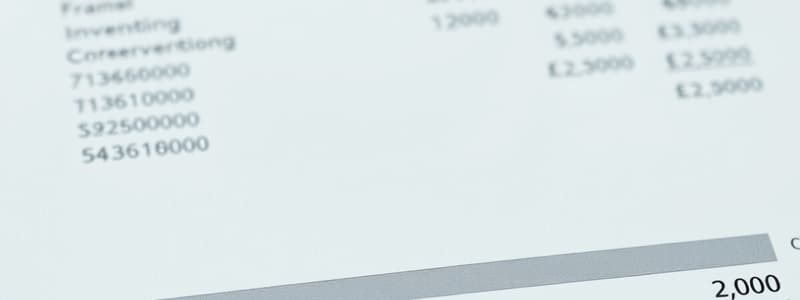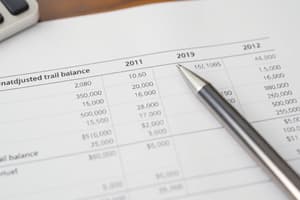Podcast
Questions and Answers
What is an unadjusted trial balance?
What is an unadjusted trial balance?
A trial balance prepared before adjusting entries are posted.
What is beginning inventory?
What is beginning inventory?
The amount of inventory on hand at the beginning of a fiscal period.
What is ending inventory?
What is ending inventory?
The actual count of merchandise at the end of a fiscal period.
What is accrued revenue?
What is accrued revenue?
What is accrued interest income?
What is accrued interest income?
What are current assets?
What are current assets?
What are plant assets?
What are plant assets?
What is depreciation?
What is depreciation?
What is depreciation expense?
What is depreciation expense?
What is salvage value?
What is salvage value?
What is useful life?
What is useful life?
What is the straight line method of depreciation?
What is the straight line method of depreciation?
What is accumulated depreciation?
What is accumulated depreciation?
What is the book value of a plant asset?
What is the book value of a plant asset?
What is an adjusted trial balance?
What is an adjusted trial balance?
What is a tax bracket?
What is a tax bracket?
What is a marginal tax rate?
What is a marginal tax rate?
Businesses must use a 12-month period, or fiscal year, ending on December 31 for reporting their financial performance.
Businesses must use a 12-month period, or fiscal year, ending on December 31 for reporting their financial performance.
The adjusting entry for Merchandise Inventory is unique to a merchandising business.
The adjusting entry for Merchandise Inventory is unique to a merchandising business.
The first step in preparing adjusting entries is to prepare an unadjusted trial balance.
The first step in preparing adjusting entries is to prepare an unadjusted trial balance.
A trial balance provides a complete list of accounts that may need to be brought up to date.
A trial balance provides a complete list of accounts that may need to be brought up to date.
Rather than using a worksheet, a business can use an unadjusted trial balance and record adjustments directly to a general journal.
Rather than using a worksheet, a business can use an unadjusted trial balance and record adjustments directly to a general journal.
The adjustment for the Supplies—Office account will result in a debit to Supplies Expense—Office.
The adjustment for the Supplies—Office account will result in a debit to Supplies Expense—Office.
The amount of the adjustment for Prepaid Insurance represents the value of the insurance premium used during the fiscal period.
The amount of the adjustment for Prepaid Insurance represents the value of the insurance premium used during the fiscal period.
For a company using the periodic inventory method, the account balance of Merchandise Inventory changes during the fiscal year.
For a company using the periodic inventory method, the account balance of Merchandise Inventory changes during the fiscal year.
If ending inventory is less than the account balance of Merchandise Inventory, the inventory adjustment will include a credit to Income Summary.
If ending inventory is less than the account balance of Merchandise Inventory, the inventory adjustment will include a credit to Income Summary.
The adjusting entry for accrued revenue increases a revenue account (a credit) and increases a receivable account (a debit).
The adjusting entry for accrued revenue increases a revenue account (a credit) and increases a receivable account (a debit).
Estimates of the cost, salvage value, and useful life of a plant asset are used to calculate its annual depreciation.
Estimates of the cost, salvage value, and useful life of a plant asset are used to calculate its annual depreciation.
Functional depreciation occurs when a plant asset becomes inadequate or obsolete.
Functional depreciation occurs when a plant asset becomes inadequate or obsolete.
The annual straight-line depreciation of equipment costing $4,000.00 with a salvage value of $500.00 and a useful life of five years would be $700.00.
The annual straight-line depreciation of equipment costing $4,000.00 with a salvage value of $500.00 and a useful life of five years would be $700.00.
The adjustment for Accumulated Depreciation—Store Equipment includes a credit to Depreciation Expense—Store Equipment.
The adjustment for Accumulated Depreciation—Store Equipment includes a credit to Depreciation Expense—Store Equipment.
The annual straight-line depreciation of land costing $40,000.00 with a salvage value of $10,000.00 and a useful life of 20 years would be $1,500.00.
The annual straight-line depreciation of land costing $40,000.00 with a salvage value of $10,000.00 and a useful life of 20 years would be $1,500.00.
The adjustment for Federal Income Tax Payable and Federal Income Tax Expense is determined only after all other adjusting entries are posted and the net income before federal income tax is determined.
The adjustment for Federal Income Tax Payable and Federal Income Tax Expense is determined only after all other adjusting entries are posted and the net income before federal income tax is determined.
Corporations anticipating annual federal income taxes of $500.00 or more are required to pay estimated taxes each month.
Corporations anticipating annual federal income taxes of $500.00 or more are required to pay estimated taxes each month.
A corporation using a 35% marginal tax rate must pay income taxes equal to 35% of its income before federal income taxes.
A corporation using a 35% marginal tax rate must pay income taxes equal to 35% of its income before federal income taxes.
Tax rates for corporations can be changed by an act of Congress.
Tax rates for corporations can be changed by an act of Congress.
Any amount of federal income tax owed at the end of the fiscal year is debited to Federal Income Tax Payable.
Any amount of federal income tax owed at the end of the fiscal year is debited to Federal Income Tax Payable.
The amount in the Supplies—Office account on an unadjusted trial balance represents the value of supplies:
The amount in the Supplies—Office account on an unadjusted trial balance represents the value of supplies:
The two accounts used to adjust the Office Supplies account are:
The two accounts used to adjust the Office Supplies account are:
The portion of the insurance premiums that has expired during a fiscal period is classified as:
The portion of the insurance premiums that has expired during a fiscal period is classified as:
The two accounts used to adjust the Prepaid Insurance account are:
The two accounts used to adjust the Prepaid Insurance account are:
For a business using the periodic inventory method, the Merchandise Inventory amount on the unadjusted trial balance represents the merchandise inventory:
For a business using the periodic inventory method, the Merchandise Inventory amount on the unadjusted trial balance represents the merchandise inventory:
The two accounts used to adjust the Merchandise Inventory account are:
The two accounts used to adjust the Merchandise Inventory account are:
A credit to Income Summary in the Merchandise Inventory adjustment represents the:
A credit to Income Summary in the Merchandise Inventory adjustment represents the:
Recording revenue in the accounting period in which the revenue is earned is an application of the accounting concept:
Recording revenue in the accounting period in which the revenue is earned is an application of the accounting concept:
The two accounts used to adjust for interest income earned on notes receivable are:
The two accounts used to adjust for interest income earned on notes receivable are:
After recording the adjustment for accumulated depreciation, the book value of plant assets:
After recording the adjustment for accumulated depreciation, the book value of plant assets:
The two accounts used to adjust the depreciation of store equipment are:
The two accounts used to adjust the depreciation of store equipment are:
The two accounts used to record the adjustment for federal income tax are:
The two accounts used to record the adjustment for federal income tax are:
Flashcards are hidden until you start studying
Study Notes
Unadjusted and Adjusted Trial Balance
- An unadjusted trial balance reflects account balances before any adjustments are made.
- The adjusted trial balance includes all adjustments post-adjusting entries.
Inventory Management
- Beginning inventory refers to the stock available at the start of the fiscal period.
- Ending inventory is the amount of merchandise counted at the end of the period, crucial for accurate financial reporting.
Revenue Recognition
- Accrued revenue, recognized in one fiscal period, is not received until a future period, highlighting cash versus earnings timing.
- Accrued interest income includes interest that has been earned but not yet collected.
Asset Classification
- Current assets are those expected to convert to cash or be utilized within one year.
- Plant assets are long-term physical assets used in operations, subject to depreciation.
Depreciation Concepts
- Depreciation measures the reduction in value of a plant asset over time due to wear or obsolescence.
- Depreciation expense represents the systematic allocation of an asset's cost over its useful life.
- The straight-line method allocates equal depreciation expense across the useful life of an asset.
Valuation and Accounting
- Salvage value is an estimate of an asset's residual worth at the end of its useful life, used in depreciation calculations.
- Book value of a plant asset is the cost minus accumulated depreciation, reflecting its current value in accounting records.
Taxation and Financial Reporting
- Tax brackets determine the applicable tax rate for various income ranges.
- Marginal tax rate indicates the tax rate corresponding to a specific tax bracket.
- Financial performance does not require a December 31 end date for fiscal years, countering a common misconception.
Adjusting Entries
- Preparing an unadjusted trial balance is the initial step for making adjusting entries, aiding in revenue and expense recognition.
- Adjustments for supplies and prepaid expenses typically involve recognizing used portions as expenses.
Fiscal Year and Income Reporting
- The financial reporting process can vary, and businesses can choose fiscal year-end dates beyond December 31.
- The matching principle requires that expenses like insurance be matched to the revenue they help to generate within a period.
Depreciation Adjustments
- Adjusting entries for accumulated depreciation affect asset valuations and income statements, reflecting asset wear over time.
Income Taxes
- Federal Income tax entries arise only after determining net income, ensuring taxes are accurately calculated based on earnings.
- Corporations must manage estimated taxes diligently, especially if projections exceed thresholds set by law.
Key Events and Corrections
- Accounting adjustments for various accounts ensure that financial statements accurately represent a company’s financial position.
- The adjustment for supplies or prepaid insurance accounts typically involves debits to expense accounts that reflect their consumption during the accounting period.
Common Misconceptions
- Corporations are not solely required to pay taxes at a set rate of income; tax rates can be influenced by legislation changes.
- Misunderstandings about how various accounts relate (like accumulated depreciation and asset cost) can impact the overall financial reporting process.
Studying That Suits You
Use AI to generate personalized quizzes and flashcards to suit your learning preferences.



